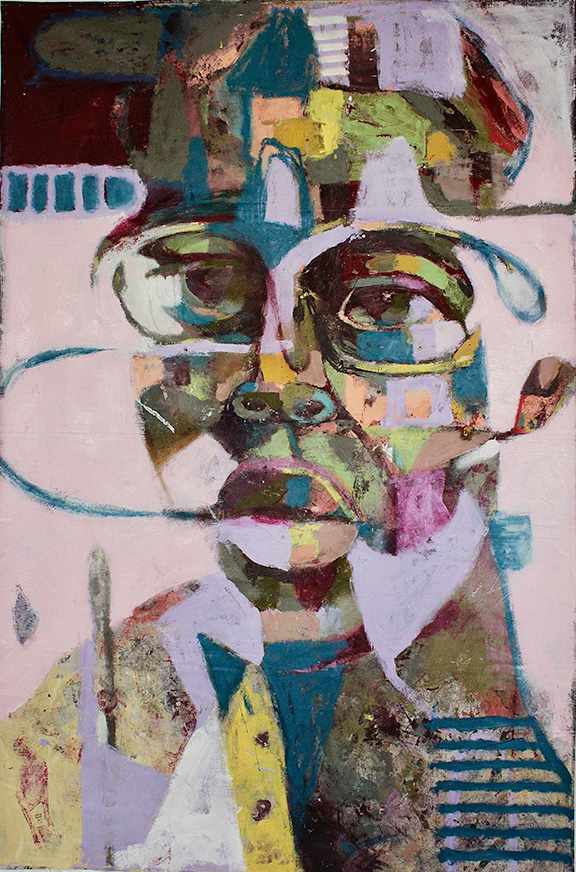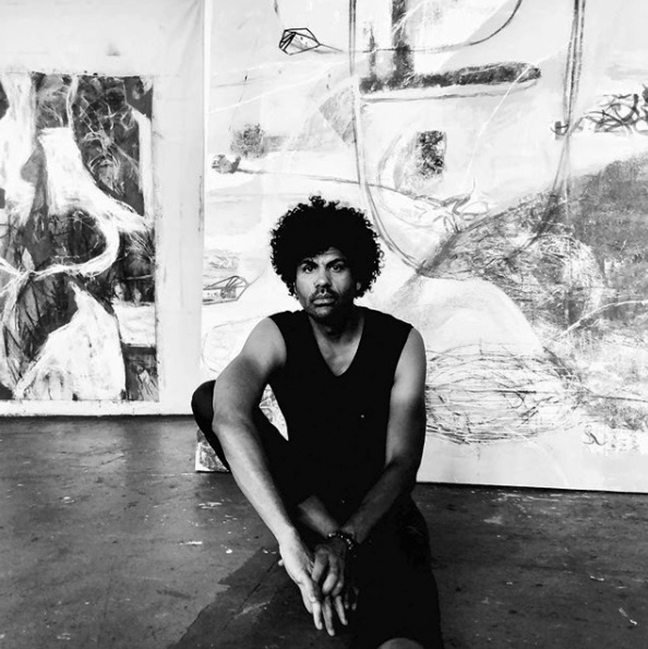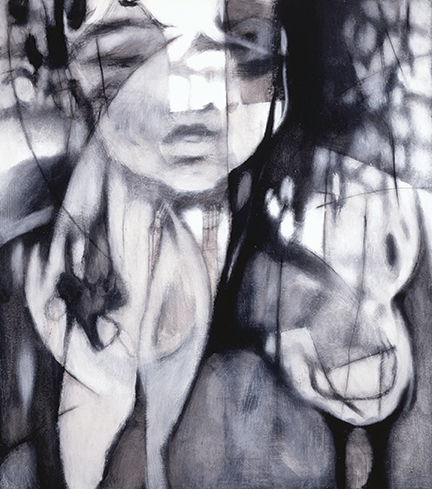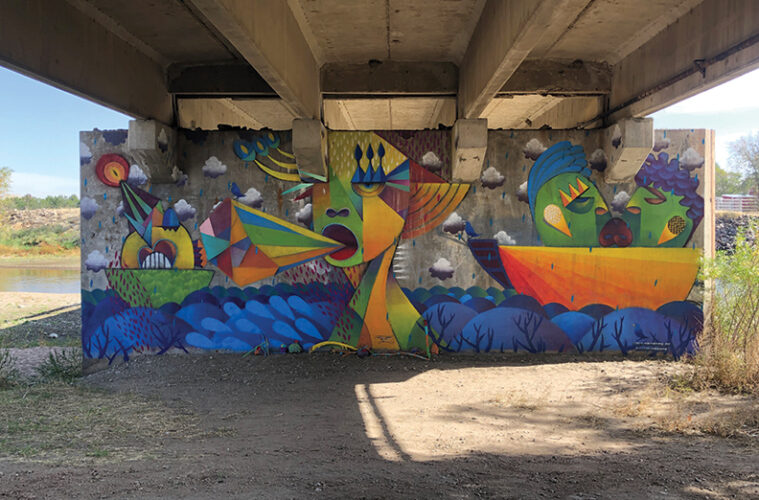BY SAM DESTEFANO
Michael Gadlin is not only an established visual artist, but he also boasts a career in television as host of Rocky Mountain PBS’ Arts District, an award-winning (two Emmy’s in 2019) half-hour arts and culture series, features local and national artists in pursuit of their artistic passions. We were so fortunate to connect with Michael, one of Colorado’s best artists and unquestionably one of our strongest ambassadors for the arts.
 You are not only a visual artist, but the television host of Rocky Mountain PBS’ Art District which has won 2 Emmy awards. How did you come to be involved with this project? What’s the focus of the show and how would you describe your experience as its host?
You are not only a visual artist, but the television host of Rocky Mountain PBS’ Art District which has won 2 Emmy awards. How did you come to be involved with this project? What’s the focus of the show and how would you describe your experience as its host?
I was so lucky to be involved with such a talented team on air and behind the show’s production. I was given a real opportunity to contribute to our television show. It enabled me to learn new ways of expressing others’ stories through this medium of making videos and writing for television. It was really a great way for me to expand my reach and understand what it takes to be involved in collaborative projects through media. Plus, being a host really taught me a whole new way of seeing myself in the public eye. There’s a lot of practice that goes in behind the scenes before you air anything in this business. All that practice gave me confidence to do more of this work for a wider audience. I think in some ways It was a chance to see myself beyond just a visual artist, but a presenter and speaker in those things that I’m passionate about sharing. The opportunity was in front of me, and with the trust of our producers, they allowed me to expand my own story and frankly what “our” story is as people of color working in local media today.
Can you tell us a little bit about your past studies in Denver and Brooklyn, as well as your residency at La Napoule Art Foundation in France?
I realized a while back how important it is to diversify my experience and knowledge base. So after Pratt in Brooklyn as a young undergrad It was important for me to follow the path of my art practice and getting as much experience in all areas as possible. I never want to stop learning or feel that my work “had arrived.” For years the library became my place of refuge, if I wasn’t in the studio I was there researching. Primarily through historical references to remain aware of the work created before me. Many of the formidable movements in contemporary art became a source of context and inspiration. It just gave me agency to be myself in my work to fuel what I wanted to say and best tell my story as an artist living today. It’s amazing what being familiar and aware of the past helps you navigate though the present and into the future. Being awarded the residency in France was also a very meaningful opportunity in my art career. Traveling abroad no doubt shaped my perspectives in every way. The art you make will always reflect your frame of reference. That residency made me realize, what you think of your art and ability in a small circle or tight community isn’t necessarily the world view of who you are and what you can be.
 In a world filed with so many artists mimicking each other and the past, what you have referred to as “the culture of sameness,” it is more important than ever for an artist to develop their own voice and thought-provoking narratives. Do you feel like this is an important part of your work? How would you describe your own style? And finally, concerning this idea, what advice would you share with upcoming artists?
In a world filed with so many artists mimicking each other and the past, what you have referred to as “the culture of sameness,” it is more important than ever for an artist to develop their own voice and thought-provoking narratives. Do you feel like this is an important part of your work? How would you describe your own style? And finally, concerning this idea, what advice would you share with upcoming artists?
You’re right. It’s really important for artists to develop their own voice and through their work explore what it means to exist in the present landscape (whatever that means for the individual). We’re no longer satisfied with what the old guard represented and how we once believed success should look like for an artist. I find artists now, myself included, are willing to step out and take creative risks, making work that is truly authentic and more personal. Make no mistake however that Art and being an artist is still a very entrepreneurial proposition and yet I feel we are in a time where the business and expressing ones truth are no longer diametrically opposed or mutually exclusive. Younger artists might have a harder time competing to find gallery representation, primarily because there aren’t as many galleries as there once were, but there’s a bit of an advantage through a variety of experimental experiences outside the usual traditions of exhibiting work.
 As someone who is intimately connected to the ever fast-evolving arts environment, how would you portray it and where do you see it going in the future?
As someone who is intimately connected to the ever fast-evolving arts environment, how would you portray it and where do you see it going in the future?
I think so much of it aligns with our willingness to make change happen and be dedicated to being change-makers. Our environment is what we make of it, and how we as artists navigate through it, which is usually an act of resistance itself. We [artists] typically don’t follow what others do rather we express ideas and concepts that bridge the gaps between communities and alliances. When walls go up, there’s an Artist [instinctively] ready to either paint the wall or knock them down to provide an alternative prospective in protest to the practicality for what the wall represents. It doesn’t serve artists well to be split. For the artist, community involvement and making work matter is the only way to successfully go into the future. What does it mean to be a change-maker? To resist the inequities and resist the old standards of being comfortable and placid with what we’re being told to compromise. The future is an interesting concept to think about and where it has the possibility to take us. If we are active in our purpose and pursuit then we can make real change happen for the benefit of fully experiencing equality.
MCA is one of our favorite museums in Denver. Tell us what it means to be on the board and what has been your favorite exhibit to date?
I’ve been part of MCA for a long time and viewed many great exhibits. So it’s really hard to pick one piece or exhibition; however, one that stands out was a piece by the artist Arthur Jafa, called, love is the message in the messages death. That is a collage of film footage that crosses many decades of the black experience. it was heavily talked about and somewhat controversial at first, but it turned out to be timely and necessary. And I think it’ll forever stick in people’s minds and the level in which MCA is willing to stretch out and be a platform for art that takes risks especially those that come from the BIPOC community. It’s an honor to be a part of the board of trustees and contribute to the museum in anyway I can. As an artist in this community it takes all of us to make change last. I know we are on the right trajectory.
 Your mural in Riverdale Park in Broomfield is powerful and thought provoking. Is there a story behind this piece?
Your mural in Riverdale Park in Broomfield is powerful and thought provoking. Is there a story behind this piece?
That mural was a really exciting opportunity for me and was created during the summer of 2020 in the depths of the pandemic. It really gave me an opportunity to express not only hope for our community at large, but also to participate in the continued work of BIPOC Artists everywhere. Just existing as an artist of color (and actively working) is in itself an act of breaking down barriers for those in our society that have been overlooked. This mural, which was commissioned by Adams County, was a chance for me to experiment and go outside of what I’m known for. Although much of the mural combines my past and present styles. I really wanted the bright palette and figurative elements to be a universal appeal for hope and healing… that we are one community when we are actively operating in an equitable and sustainable space.
In 1999 you were the youngest artist ever to win Best of Show at the Cherry Creek Arts Festival. Clearly you know the incredible impact art can have in a young person’s life. Tell us about your dedication to educating not only budding artists, but also the underserved and special needs artists of all ages in our community.
Yeah, that was an interesting time to have that kind of success at such a young age. I’ve always had my own style and discovering my own process was an important part of my development. Being an artist meant having the discipline in the practice of my craft. So for me being an artist was about every decision I made. It revolved around what supports this life in art and how can I continue to develop. I had people around me that believed in my work and gave me opportunities to thrive. However, opportunities don’t come easy, I feel it’s part of an artist’s journey to find where they fit and can develop and thrive. I made it my personal responsibility to share my passion in any way I can by giving other young artists the help and supplies they need. Artists have always been reliant on their community and so it is also, visa-versa. By creating spaces that give place for experiences that open up opportunities for artists to share and develop. By this, I mean, when we collaborate and work together artists build a creative community that feeds off the energy everyone puts in. Artists are creating greater agency in a world and a time where we need balance and in some ways provide meaning in an environment we find unpleasant. We all know that art is a universal language and it often crosses many barriers of class, race and privilege. So it’s our responsibility to continue to “build art and tear down walls” for our communities. we can thrive by speaking truth and by providing equitable opportunities for those who find themselves on the fringes of society.
You’ve said that your intent is to explore visual elements that excite the viewer’s senses. This is precisely the response we had upon seeing your work at the Tattered Cover. Both you and the new owner Kwame Spearman are East High alumni. Is this how you first connected? Tell us more about their recent artist outreach program and what it’s like to be their first artist to display work in their Colfax location.
It’s really quite an honor to be the first in the program and to collaborate with Tattered Cover in a way that leans toward showcasing artists from diverse backgrounds. I feel like the partnership steps into the space of equitability and creates opportunity for many artists in and around our city. Kwame and I have quite similar backgrounds and surprisingly never crossed paths until we were introduced recently from a mutual friend. But, it’s been a friendship that feels like we’ve known each other longer because of how much we have in common.
After 20+ years in the art scene, your portfolio is immense. What can we expect to see from you in the future?
That’s a great question. I think I’m always looking to reach beyond what’s expected of me. Experiment more. I’m very conscious of what’s going on around me and I desire my work to reflect the moment I’m living in. The idea of the future of my art intrigues me. With so many years behind me I’m driven to make work that can sit in any decade or century; but of course history will be the judge of that.
Thank you so much, Michael, for sharing your story, your artistic gifts and love of the arts with our local community.

